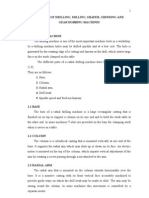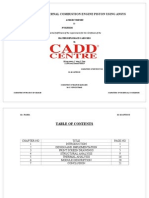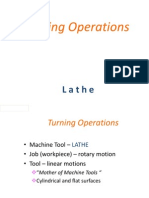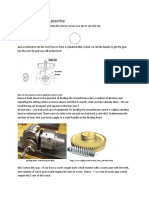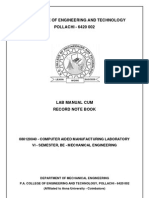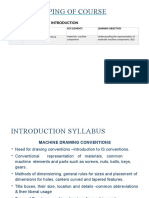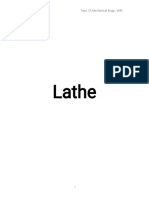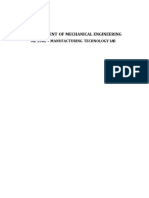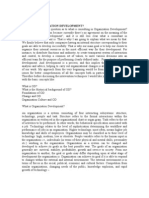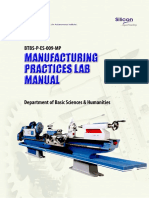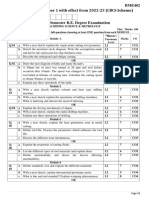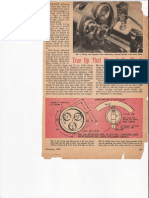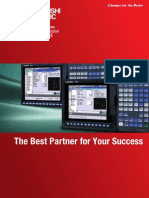Machine Tools Lab Manual
Uploaded by
Phani GurijalaMachine Tools Lab Manual
Uploaded by
Phani Gurijala1
TIRUMALA ENGINEERING COLLEGE
Approved by AICTE, New Delhi
and
Affiliated by JNTUK, KAKINADA
MECHANICAL ENGINEERING DEPARTMENT
MACHINE TOOLS LAB MANUAL
Prepared by
Faculty Members of Mechanical Engineering Department
(2012 13)
TIRUMALA ENGINNERING COLLEGE
Jonnalagadda(Post),
Narasaraopet(Mandal),
Guntur(District),
AndhraPradesh.
PIN-522601
Machine Tools Lab
CONTENTS
1. FOREWORD WITH SPECIAL EMPHASIS ON IMPORTANCE OF
THE LABORATORIES
2. List of experiments
1. Introduction of general purpose machines lathe, drilling machine, milling machine,
shaper, planning machine, cylindrical grinder, surface grinder and tool & cutter
grinder.
2. Step turning and taper turning on lathe machine
3. Thread cutting and Knurling on lathe machine
4. Drilling and Tapping
5. Shaping and Planning
6. Slotting
7. Milling
8. Cylindrical surface grinding
9. Grinding of tool angles
Page 2 of 32
Machine Tools Lab
FOREWORD WITH SPECIAL EMPHASIS ON
IMPORTANCE OF THE LABORATORIES
The dawn of the new millennium, symbolizes globalization and liberalization policy in our
country. In one stroke, this phenomenon has resulted in the challenging task of imparting world
class technical education. It is a fact that technology drives the modern society. Keeping the
challenges in mind, the successful delivery of the education philosophy is divided into two interrelated components, namely, theory and practical. The practical have to support in assimilation
and thorough understanding of the theoretical content in a subject.
All the laboratory procedures are designed and developed to meet the fast growing
challenges in the area of the specialization and as per the curriculum of Mechanical Engineering
branch. The manual is prepared to meet the academic, industrial and personality building
challenges.
The layout of each lab, list of experiments, description, possible calculations, expected
graphs and related questions in each lab are provided with possible quiz questions. This whole
exercise helps in thorough understanding of each experiment, the total experiments in a lab and all
the laboratories in the department. This approach, for sure, will help the students in understanding
and usage of latest technologies.
(Head, Department of Mechanical Engineering)
MACHINE TOOLS LAB
Page 3 of 32
Machine Tools Lab
Expt.No :
Date:
INTRODUCTION TO GENERAL PURPOSE MACHINES
AIM: To study working principle of Lathe, Drilling machine, Milling machine, Shaper, Planning
machine, Slotting machine, cylindrical grinder, surface grinder and Tool & Cutter grinder
machine
EQUIPMENT:
1. Lathe
2.Drilling machine
3. Milling machine
4.Shaper
5. Planning machine
6. Slotting machine
Page 4 of 32
Machine Tools Lab
7. Grinder
Description and Working Principle:
LATHE
The lathe is one of the oldest machine tool and comes to existence from the early tree lathe.
The main function of the lathe is to remove metal from a piece of work to give it the required
shape and size. This is accompanied by holding the work securely and rigidly on the machine and
turning it against cutting tools which will remove metal from work in the form of chips.
The classifications of lathe machines are as follows
1. Speed lathe.
2. Engine lathe.
3. Bench lathe.
4. Tool room lathe.
5. Capstan and turret lathe.
6. Special purpose lathe.
7. Automatic lathe.
The size of lathe is specified by
1. Height of centers.
2. Swing diameter over bed.
3. Length between centers.
4. Swing diameter over carriage.
5. Maximum bar diameter.
6. Length of bed
Parts of lathe:
Page 5 of 32
Machine Tools Lab
1) Bed: The lathe bed forms the base of the machine. The head stock and tail stock are located at
either end of the bed and the carriage rests over the lathe bed and slides over it. The lathe bed should
be sufficiently rigid to prevent deflection under tremendous acting pressure. It must have sufficient
depth and width to absorb vibrations.
2) Headstock: Head stock is secured permanently on the inner ways at the lift had end of the lathe
bed and it provides mechanical means of rotating the work at multiple speeds. It comprises
essentially of a hollow spindle and mechanism for driving and altering spindle speeds. All parts are
housed with in head stock casing. In a lathe it is necessary to vary the speeds of the work to suit
different machining conditions.
a) Belt on cone pulley fitted on head stock spindle with or with out back gear arrangement.
b) By all gear drive using sliding gears or clutches.
c) By variable speed motor.
3) Tail stock or loose head stock: The tail stock is located on the inner ways at the rigid head end
of the bed. This has two main uses one to support the other end of work and other it holds a tool for
performing operations like drilling, reaming and tapping etc.
4) Carriage: The carriage of the lathe has several parts that serve to support, move, and control
the cutting tool. It consists of following parts:
a) Saddle: The saddle is an H-shaped casing that fits over the bed and slides along the ways.
It carries the cross slide and tool post.
b) Cross slide: It carries locations on the upper face of the tool post or compound rest.
c) Compound rest: The compound rest or compound slide is mounted on the cross slide and has a
Page 6 of 32
Machine Tools Lab
circular base graduated in degrees. It is used for obtaining angular cuts and short tapers as well as
convenient positioning the tool to the work.
d) Tool post: It is located on top of compound rest to hold the tool and to enable it to adjust to a
convenient working position.
e) Apron: It is sustained to the saddle and hangs over the front of the bed. It contains gears,
clutches, and levers for operating the carriage by hand and power feeds.
5) Feed mechanism: The movement of the tool related to the work is termed as feed. A lathe tool
may have three types of feed--longitudinal, cross and angular. The feed mechanism has different units
through which power is transmitted from the head stock spindle to the carriage. The units are: End of
gear bed, Feed gear box, Feed rod, lead screw and Apron mechanism.
6) Thread cutting mechanism: The rotation of lead screw is used to transverse the tool along the
work to provide screw thread. The half nut mechanism makes the carriage to engage or disengage
with the lead screw.
Lathe accessories and attachments: These include centers catch plates, carriers, chucks, collets,
face plates, angle plates and mandrels. They are either used for holding and supporting work or
holding the tool.
The various chucks are, four jaw independent chuck, three jaw universal chuck, magnetic chuck,
collect chuck, combination chuck, drill chuck etc.
The various operations that can be performed on lathe are:
1) Straight turning.
2) Shoulder turning.
3) Chamfering.
4) Thread cutting.
5) Facing.
6) Knurling.
7) Fitting.
8) Taper turning.
9) Eccentric turning
10) Positioning.
11) Grooving.
12) Spinning.
13) Spring winding.
14) Forming.
DRILLING MACHINE
The radial drilling machine is intended for drilling holes to large and heavy work piece.
This consists of a heavy round vertical column mounted on a large base. The column
supports a radial arm which can be raised and lowered to accommodate work piece of
different heights. The arm may be swing around to any position over the work bed. The
drill bed containing mechanism for rotating and feeding the drills mounted on a radial arm
and can be moved horizontally on the guide ways and clamped at any desired position. The
three movements in radial drilling machine when combined together permit the drill to be
located at any desired point on a large work piece for drilling of the hole.
Parts of drilling machine :
Page 7 of 32
Machine Tools Lab
1) Base: The base of a radial drilling machine is large rectangular casing that finished on
its top to support a column that is on one end and hold the work table at the other end.
2) Column: The column is cylindrical casing that is mounted on one end of base. It
support the radial arm which may slide up or down on its face.
3) Radial arm: It is mounted on column extends horizontally. Guide ways are provided
on which drill head may be made to slide.
4) Drill head: It is mounted on the radial arm and drives the drill at multiple speed and
different speed.
5) Spindle drive and feed mechanism: There are two common methods of drilling the
spindle a) contact speed motor is mounted at extreme end of radial arm, b) train of gearing
with in the drill head.
MILLING MACHINE
A milling machine is a machine tool used to machine solid materials. Milling is the
process of machining flat, curved, or irregular surfaces by feeding the workpiece against a
rotating cutter containing a number of cutting edges. The milling machine consists basically
Page 8 of 32
Machine Tools Lab
of a motor driven spindle, which mounts and revolves the milling cutter, and a reciprocating
adjustable worktable, which mounts and feeds the work-piece.
The different types of milling machines are,
Milling machines are basically classified as being horizontal or vertical to indicate the axis
of the milling machine spindle. These machines are also classified as knee-type, ram-type,
manufacturing or bed type, and planer-type milling machines. Most machines have selfcontained electric drive motors, coolant systems, variable spindle speeds, and power operated
table feeds
Parts of Milling machine :
Colum: The column, including the base, is the main casting which
supports all other parts of the machine. An oil reservoir and a pump in
the column keeps the spindle lubricated. The column rests on a base
that contains a coolant reservoir and a pump that can be used when
performing any machining operation that requires a coolant.
Knee: The knee is the casting that supports the table and the
saddle. The feed change gearing is enclosed within the knee. It is
supported and can be adjusted by the elevating screw. The knee is
fastened to the column by dovetail ways. The lever can be raised or
lowered either by hand or power feed. The hand feed is usually used to
take the depth of cut or to position the work, and the power feed to
move the work during the machining operation
Saddle and Swivel Table: The saddle slides on a horizontal dovetail,
parallel to the axis of the spindle, on the knee. The swivel table (on
universal machines only) is attached to the saddle and can be swiveled
approximately 45 in either direction.
Power Feed Mechanism: The power feed mechanism is contained in
the knee and controls the longitudinal, transverse (in and out) and
vertical feeds. The desired rate of feed can be obtained on the machine
by positioning the feed selection levers as indicated on the feed
selection plates. On some universal knee and column milling machines
the feed is obtained by turning the speed selection handle until the
Page 9 of 32
Machine Tools Lab
desired rate of feed is indicated on the feed dial. Most milling machines
have a rapid traverse lever that can be engaged when a temporary
increase in speed of the longitudinal, transverse, or vertical feeds is
required. For example, this lever would be engaged when positioning or
aligning the work.
Arbor Support: The arbor support is a casting containing a bearing which aligns the outer
end of the arbor with the spindle. This helps to keep the arbor from springing during cutting
operations. Two types of arbor supports are commonly used. One type has a small diameter
bearing hole, usually 1-inch maximum in diameter. The other type has a large diameter
bearing hole, usually up to 2 3/4 inches. An oil reservoir in the arbor support keeps the
bearing surfaces lubricated. An arbor support can be clamped
Table: The table is the rectangular casting located on top of the
saddle. It contains several T-slots for fastening the work or work holding
devices. The table can be moved by hand or by power. To move the
table by hand, engage and turn the longitudinal hand crank. To move it
by power, engage the longitudinal directional feed control lever. The
longitudinal directional control lever can be positioned to the left, to the
Page 10 of 32
Machine Tools Lab
right, or in the center. Place the end of the directional feed control lever
to the left to feed the table to the left. Place it to the right to feed the
table to the right. Place it in the center position to disengage the power
feed, or to feed the table by hand.
Spindle: The spindle holds and drives the various cutting tools. It
is a shaft, mounted on bearings supported by the column. The spindle is
driven by an electric motor through a train of gears, all mounted within
the column. The front end of the spindle, which is near the table, has
an internal taper machined on it. The internal taper (3 1/2 inches per
foot) permits mounting tapered-shank cutter holders and cutter arbors.
Two keys, located on the face of the spindle, provide a positive drive for
the cutter holder, or arbor. The holder or arbor is secured in the spindle
by a drawbolt and jamnut, as shown in figure 3 on the following page.
Large face mills are sometimes mounted directly to the spindle nose.
Overarm: The overarm is the horizontal beam to which the arbor
support is fastened. The overarm, may be a single casting that slides in
the dovetail ways on the top of the column. It may consist of one or two
cylindrical bars that slide through the holes in the column. On some
machines to position the overarm, first unclamp the locknuts and then
extend the overarm by turning a crank. On others, the overarm is
moved by merely pushing on it. The overarm should only be extended
far enough to so position the arbor support as to make the setup as
rigid as possible. To place the arbor supports on an overarm, extend one of the bars
approximately 1-inch farther than the other bar.
The milling machine removes metal with a revolving cutting tool called a milling cutter.
With various attachments, milling machines can be used for boring, slotting, circular milling
dividing, and drilling. This machine can also be used for cutting keyways, racks and gears
and for fluting taps and reamers.
Milling machines are often classed in two basic forms, horizontal and vertical, which
refers to the orientation of the main spindle. Both types range in size from small, benchmounted devices to room-sized machines. Unlike a drill press, which holds the work piece
stationary as the drill moves axially to penetrate the material, milling machines also move the
work piece radially against the rotating milling cutter, which cuts on its sides as well as its
tip. Work piece and cutter movement are precisely controlled to less than 0.001 in
(0.025 mm), usually by means of precision ground slides and leadscrews or analogous
technology. Milling machines may be manually operated, mechanically automated, or
digitally automated via computer numerical control.
Milling machines can perform a vast number of operations, from simple (e.g., slot and
keyway cutting, planing, drilling) to complex (e.g., contouring, die sinking). Cutting fluid is
often pumped to the cutting site to cool and lubricate the cut and to wash away the resulting
swarf.
Page 11 of 32
Machine Tools Lab
Page 12 of 32
Machine Tools Lab
SHAPER
The shaper is a reciprocating type of machine tool intended primarily to produce flat
surfaces. These surfaces may be horizontal, vertical or inclined.
The different types of shapers are.
1) According to mechanism.
a) Crank angle.
b) Geared type.
c) Hydraulic type.
2) According to travel of ram.
a) Horizontal.
b) Vertical.
c) Traveling head type.
3) According to type of design.
a) Standard Shaper.
b) Universal Shaper.
4) According to type of cutting stroke.
Page 13 of 32
Machine Tools Lab
Parts of a shaping machine:
1) Base: The base necessary bed or support required for all machine tools. It is so
designed that can take up the entire load of the machine and the forces setup by cutting tool
over the crank.
2) Column: The column is a box like casing mounted up on the base. It encloses the ram
driving mechanism. Two accurately machined guide ways are provided on the top of the
column on which ram moves.
3) Cross rail: The cross rail is mounted on vertical guide ways of the column. The table
may be raised or lowered to accommodate different sizes of jobs by rotating on elevating
screw which causes the cross rail to slide up and down on vertical face of column.
4) Saddle: The saddle is mounted on the cross rail which holds the table firmly on its top.
Crosswise movement of the saddle by rotating the cross screw by hand power causes table
to move in ways.
5) Ram: The ram is the reciprocating member of the shaper it slides on accurately
machined guide ways on top of the column and is connected to the reciprocating mechanism
contained with in the column.
6) Tool head: The tool of a shaper holds the tool rigidly provides vertical and angular
feed movement of the tool and allows the tool to have an automatic relief during its return
stroke.
SLOTTING MACHINE
The slotting machine falls under the category of reciprocating type of machine tools
similar to shaper or planer. The major difference between a shaper or slotter is that ram
moves in a vertical direction in slotter & horizontal direction in shaper. A vertical shaper
differs from slotter as the ram reciprocates at any angle of 5 Degrees to vertical the slotter
is use for cutting grooves, key ways & slots of various shapes etc...
Parts of a slotting machine:
1) Base or bed: The bed is rigidly built to take up all the cutting forces & Entire load of
the machine. The top has guide ways for movement of saddle.
2) Column: The vertical member, which is cast integral with the base & houses driving
mechanism.
3) Saddle: The saddle is mounted on the guide ways and may be moved towards or away
from the column either by power or manual control.
Page 14 of 32
Machine Tools Lab
4) Cross slide: It is mounted up on the saddle and may be moved parallel to the face of
the column.
5) Rotary table: The rotary table is circular table which is mounted on the top of the
cross slide. The table may be rotated by rotating a worm, which meshes with a worm gear
connected to under side of table.
6) Ram and tool head: The ram is reciprocating member. It supports tool at the bottom
head.
7) Ram drive mechanism: This mechanism is used to reduce the idle time.
8) Feed mechanism: In slotter feed is given by Table & slotting machine table may have
three types of feed movements.
a) Longitudinal, b) Cross, c) Circular.
GRINDER
Grinding is a metal cutting operation performed by means of a rotating abrasive wheel
that acts as a tool. This is used to finish work pieces which must show a high surface
quality, accuracy of shape and dimension.
The different kinds of grinders are:
1) Rough grinders:
a) Floor stand and bench grinders.
b) Portable and flexible shift grinders.
c) Swing frame grinders.
d) Abrasive belt grinders.
2) Precision grinders:
a) Cylindrical grinders.
b) Internal grinders.
c) Surface grinders.
d) Tool and cutter grinders.
e) Special grinding machines.
Page 15 of 32
Machine Tools Lab
Surface grinding machines are employed to finish plane or flat surfaces. They are also
capable of grinding irregular, curved, convex and concave surfaces.
Surface grinders are of different kinds.
a) Horizontal spindle reciprocating table.
b) Horizontal spindle rotary table.
c) Vertical spindle reciprocating table.
d) Vertical spindle rotary table.
The majority of surface grinders are of horizontal table type. In the horizontal type of
machine, grinding normally is done on the periphery of the wheel. The area of contact is
small and the speed is uniform over the grinding surface. Small grain wheel is used and
finest finishes obtained.
Parts of horizontal surface grinding machine :
1) Base: It has a column at the back for supporting wheel head. The base also contains
drive mechanism.
2) Table: The table is fitted to the saddle carefully on machined ways. It reciprocates
along ways to provide through longitudinal feed. T-slots are provided in table surface for
clamping work pieces
Directly on table or for clamping grinding fixtures or a magnetic chuck. On some
machines the table can also move in or out from the vertical column which supports the
wheel head. This movement is known as cross feed.
3) Wheel head: The wheel head is mounted on the column secured on the base. It has
ways for the vertical slide which can be raised or lowered with the grinding wheel.
Manually by rotating a hand wheel work pieces of different heights can be accommodated
and wheel can be set for depth of cut.
Page 16 of 32
Machine Tools Lab
RESULT:
Expt.No :
Date:
Page 17 of 32
Machine Tools Lab
PLAIN TURNING
AIM: to plain turning operation for the given work piece on a central lathe as well drawing.
MATEERIALS REQUIRED: Mild steel bar stock dia 25mm and 120 mm length.
TOOLS REQUIRED: central lathe (three jaw self centering chuck), turning tool, out side
caliper ,tool holder with key,check key,high speed steel cutting tool bit.
PROCEDURE:
1.load the bar stock in the check.
2.rotate the chech by and check the connecting end of the barstock and also its alignment.
3.make necessary correction if required.
4.face the end using racing tool.
5.plain turn dia for the total required length(100mm) of the work piece.
PRECAUTIONS:
1.required safety equipment must be used during operation.
2.check key should be removed from the check before operating the lathe machine.
3.work should be fitted highly in the check.
4.the power supply must be switched of before measuring diameters with calipers.
RESULT:
The plane turning operation is done.
Expt.No :
Date:
STEP TURNING &UNDER CUTTING
AIM :to perform step turning and under cutting operation for the given work piece on a as per
drawing.
MATERAILS REQUIRD:m.s bar stock dia 25mm*105mm length.
Page 18 of 32
Machine Tools Lab
TOOLS REQUIRED: central lathe (three jaw self centering chuck), turning tool, racing tool, steel
rool, at side caliper ,total holder with key, chuck key, high speed cutting tool bit.
PROCEDURE:
1. Load the bar stock in the head the stock chuck.
2. Rotate the chuck by and chuck the connecting end of the bar stock and also its alignment.
3. Make necessary correction if required.
4. Face the end using facing tool.
5. Plain turn dia 23 for the total required length(100mm)of the work piece.
6. Using a parting tool of 25mm cutting edge make two under cuts for dia 12mm.
PRECAUTIONS:
1. Required safety equipment must be used during operation.
2. Chuck key should be removed from the chuck before operating the lathe machine.
3. Work piece should be fitted tightly in the chuck.
4. The power supply must be switched off before measuring diameters with calipers.
RESULT:
STEP TURNING OPERATION IS PERFORMED
Expt.No :
Date:
KNURLING AND TAPER TURNING
AIM:To perform knurling and tapper turning operation for the given work piece on a central lathe
as per drawing.
APPRATUS MATERIAL REQUIRED:
Mild steel(m.s)bar stock of dia 25mm and 105mm length.
TOOLS REQUIRED:
Central lathe(3 jaw self centering chuck) turning tool facing tool, steel rule aside caliper tool
holder with key high speed steel cutting tool bit.
PROCEDURE:
Page 19 of 32
Machine Tools Lab
1. Load the bar stock in the chuck.
2. Rotate chuck by hand check the concentricity of the bar stock with tial stock center and tip of
tool in the tool post.
3. Make necessary corrections if required.
4. Face end using facing tool.
5.Plain turn dia 23 for total required length (100mm)of the work piece.
6.Using a parting tool of 2mm cutting edge make 2 under as per dia 18 ,and dia 12mm.
7. Hold the knurling tool in the tool post and reed at aerosy the work axis mainting the tool
pressure on the job move the total left to right and right to left to provide knurls at appropriate
lacations at the job.
8.taper turning calculate the angle for compound rest swiver and set the compound test at the angle
holding the same turning tool in position as eaelier turning operations.
9.now turn the taber by moving the cross side from right to left or left to right.
10.several passes have to made fill required taper is obtained taper angle.
tan/2)=(D-d)/2
i.e /2=tan-1[(D-d)/2]
PRECATIONS:
1.Required safety equipment must be used during the operation.
2. Chuck should be removed from the chuck before operations the lathe nye.
3.Work piece should be fitted tightly in the chuck.
4. Power supply must be switched off measuring diameters with calipers.
RESULT:
The knurling and tapering is performed successfully.
Page 20 of 32
Machine Tools Lab
Expt.No :
Date:
THREADING
AIM:
To perform threading operation for the given work piece ona central lathe as per drawing.
MATERIALS REQUIRED:
Mild steel (ms)bar stock of dia 25mm and 105mm length.
TOOLS REQUIRED:
Central lathe (3 jaw self centering turning tool ,facing tool,steel rule outside calipers with key
chuck key high speed cutting tool bit.
PROCEDURE:
1.load the bar stock in the chuck.
2.rotate the by hand the connecting and of the bar stock and also its alignment.
3.make necessary corrections it required.
Page 21 of 32
Machine Tools Lab
4.face the edge using facing tool.
5.plain turn dia 23 for the total requirement length(100mm)of the work piece.
6.using aparting tool of 2mm cutting edge make two under as per dia 18 dia 12mm.
7.turn 12mm dia for threading length.
8.use a chamber tool and a chamber at the end of threaded position.
PRECAUTIONS:
1. Required safety equipment must be used during the operation.
2. Chuck key should be removed from the chucks before operating the lathe machine
3. Workpiece should be fitted tightly in the chuck
4. The power supply mst be switched off before measuring diamejters with calipers.
Result::
The threading is perfoemed successfully.
Expt.No :
Date:
SLOTTING
AIM: To perform slotting operation on a gear blank.
TOOLS:
Slotting tool,vernier calipers, drill bit,v-tool scale 15mm,boring tools.
MATERIAL REQUIRED:
Gear blank(1mm)
MOTOR CAPACITY:2HP MOTOR.
THEORY:
It almost operates on the same principle as that of the shaper. a vertical shaper and slotter are
almost similar to each other as regards their construction operation and major difference between a
slotter and shaper if that in a slotter, the ram holding the toolreciprocates in a vertical axis. when as
in shaper ,the ram holding to the tool reciprocates in a horizontal axis the sloter is used for cutting
grooves
Page 22 of 32
Machine Tools Lab
RAM DRIVE MECHANISM:
A slotter removes metal during down word cutting stroke only where as during upward return
stroke no metal is removed. the usual types of ram drive mechanism are
1.whit worth quick return mechanism
2.variable speed reversible motor drive mechanism.
3.hydralic drive mechanism.
FEED MECHANISM
Ina slotter the feed is given by the table.a slotting machine table may have three types of feed
movements.
1.machining flat surface .
2.machining cylindrical surface.
.
3.machining irregular surface and cam machining.
4.machining slotes ,keyways and grooves.
SLOTTING MACHINE PARTS:
The different parts of a slottong machine are
1.base
2.column
3.saddle
4.cross-slide
5.rotating table
6.ram and tool head assembling
7.ram device mechanism
8.feed mechanism
SLOTTER SIZE:The size of a slotter like that of a shape is specified by the maximum length of stroke of the ram
expressed in mm.the size of general purpose or precision slotter usually ranges from 80 to 100mm.
CUTTING SPEED &DEPTH OF CUT:
Similar to a shaper ,the witting speed of a sloter is defined by the rate with which the matal is
removed during downward cutting stroke &its expressed in meters per minute.
PROCEDURE:1.cut the specimen from 60 dia m.s using proper hack saw.
2.do the racing operations and plain turning operations on all gear multipurpose lahe.
3.do the drilling operations with pilot drill 10.5 mm,12mm and atleast 30mm drill bit, always use
lubricant to reduce heat produce.
Page 23 of 32
Machine Tools Lab
4.fix the specimen work piece on the tasle using chuck on any holding device firmly.
5.center the position of specimen &chuck the langth of stroke.
6.give transvers feed slowly two to three times divisions.
7.in the indexing mechanism the table rotates or computer rotation.
8remove the work piece from work holding devices.
9.always the cutting stroke should be slow return stroke should be fast.
PRECATIONS:1.tight the chuck firmly on work holding device it hold the work piece.
2.always the nus of working table should be tight while working.
3.sharp the edges of slotting tools before starting.
4.the feed should be low in order to prevent breaking of tool while working.
5.use lubricant oil while working.
RESULT:The required work piece is completed with pressured dimensions.
Expt.No :
Date:
SHAPING
AIM:using shaping machine to plain the surface and cutting a slot.
TOOLS REQUIRED:1.STEEL RULE
2.V-TOOL
3.12 AND 13MM SPANNER.
MATERIALS REQUIRED:53*53 square block of c.I material.
SHAPING MACHINE:- The shaping machine is used for producing flat surface on flat work
pieces
Generally shapes are three types
1.horizontal shaper
2.vertical shaper
3.travelling head shaper
HORIZONTAL SHAPER:Ram holding the cutting tool moves in horizontal plane and is used for producing flat surfaces.
VERTICAL SHAPER:Ram holding the cutting tool moves in vertical and is used to cut keyways.
Page 24 of 32
Machine Tools Lab
TRAVELLING HEAD SHAPER:Ram holding cutting tool reciprocates and simultaneously move cross wise to give required feed
and used for heavy jobs.
THE BASIC COMPONENTS OF HORIZONTAL SHSPES ARE
1.BASE:The base if made of cI and if mounted rigidly on the floor or on the bench depending upon the size
of the machine.
2RAM:-.the ram is the main moving part of shaper and it carries the tool head that provides
cutting action. It connected to driving mechanism contained with in the column.
3.TABLE:-the table is box like casting with t-slots at on its top the slot used for hold vice.
4.SADDLE:-the saddle is mounted on cross rail &supports the table .it moves a cross the cross rail
from left to right by cross feed screw.
5.CLAPPER:-the clapper box (tool block)is to the tool head .it swings out wards on the return
stroke to that the cutting tool lift slightly and clear the work .
WORKING PRINCIPLE OF A SHAPER:The working principle of a shaper is illustrated in rigure . in case of shaper the job is
rigidly held in a suitable device like a vice or clamprd directly on the machine table.the tool is used
in tool post mountsd on the ram of the machine table.this ram reciprocating to pro and is doing so
makes the tool at the material in the forward stroke.no cutting of material take place during the
return stroke of the ram.
SPECIFICATIONS OF SHAPER:1.maxmum length of stroke of the ram.
2.type of drive
3.type of speed reduction
4.power input b
5.cutting ti return stroke radio
6.floor space required
Several different shapes of job can be produced on shapes
1.horizontal cutting
2.vertical cutting
3.angular cutting
4.key way groove slot cutting
5.irregular cutting
QUICK RETURN MECHANISM:All the shaprs except the draw at types ,at in forward stroke only and the return stroke is
idle.the time spent in this stroke is obvisously .a waste similarly in a draw at shaper ,the forward
stroke is idle and the time takes by this stroke is also wasted.however fast this idle stroke is made
it.the two common measuring used for this purpose are
.1.crank and slotted link mechanism
2.hydraulic mechanism
Page 25 of 32
Machine Tools Lab
PROCEDURE:1.the work piece is fixed in the vice .
2.the v-tool is fixed in the required passion in tool holder.
3. planning is done on far sides of block.
4.making is done for cutting slot.
5.0.5mm feed is given for each stroke.
6.used table feed mechanism at a slot upto a required depth.
7.remove the work piece after completion of operation.
PRECAUTIONS:1.fix the work piece in the vice tightly.
2.adjust the length of stroke of arm before starting the operation.
3.the edges of cutting tool should be sharp.
4.lubrication is applied for cool the tool.
5.only cutting stroke feed will be given.
RESULT:Planning operation and cutting slot on a given output to required dimensions using horizontal
shaper.
Expt.No :
Date:
SURFACE GRINDING
AIM:
To perform surface grainding operation on a given rectangular plate
TOOL REGUIRED
1.Steel plate
2.vernier calipers
3.brush
4.dail gauge
5.magnetic stand
MATERIAL REQUIRED
5.41*38.4 rectangular plate with 8.5mm thickness&mild steel
MACHINE REQUIRED
Surface grainder with 2HP motor with 2586RPM
GRAINDING WHEEL REQUIRED
Carborading grit medium resign bonded highly refired AL2O3 AA60 KSU17
A: manufactures abrasive symbol (use options)
Page 26 of 32
Machine Tools Lab
Abrasive aluminum oxide
Silicon carbonate
-A
-c
60: grain size
Coarse
10
12
14
20
24
medium
30
36
46
54
60
K:grade
Grade scale
Soft
Medium
Hard
S:Structure
Derse: 1
Open:
10
11
12
13
14
15
16
Page 27 of 32
Machine Tools Lab
V :bond type
V=vertical bond
B=resionoid
E=shellae
S=silicon
O=oxy chloride
SUFFIX: Manufacture abrasive
Type:SYBOL
The common classifications of surface grainds can be made as fallows
1:According to table movement as
a) reciprocating table type.
b) Rotary table type.
1. A ccording to the direction of wheel spindles.
a) Vertical spindle type
b) Horizontal spindle type
2.
Special type and single purpose machines
a) Race grainding
b) Way grainding
c) Wet belt grainding
HORIZONTAL SPINDLE RECIPROCATING TABLE
The block diagram of a straight wheel horizontal spindle reciprocating
Table surfaces grider this as the following main parts.
1.Column
2.Table
3.Wheel head
Principle : The principle of grainding is applied to reciprocating table types surfaces grainding.
Page 28 of 32
Machine Tools Lab
Operations: The work piece reciprocates under the wheel .The table feed axially between passes
to produces a fire flat surfaces wheel down feed determaines depth of cut and final straight of the
piece from the table to the wheel.
The amount of feed must only equal of flow hundread of millimeters for enough
steel is rough ground with a depth of cutting 0.02&0.015mm and finish ground with a depth of
cut at 0.05-0.01mm.
Procedure:
1.Measure the given specimen for the given dimensions .
2. Fix the given specimen on the tangent chuck.
3. Adjust the column of surface grading such that the specimen by adjusting the vertical fix
adjustment.
4.Given vertical speed slowly
1micro=0.002
1rev =1.25mm
1dia =0.01mm
No.of divisions on wheel=25
No.of divisions on feed=23
5.Always give half rotations on transfers feed which move the work piece by 0.05mm
6.Try to get smooth surface in all directions by using vertical transvers and longitudinal feet
7.Always prefer low speed in all three directions for five surfaces.
MODEL CALCUALTIONS:
1 MICRO =0.002
0.002 X 15 = 0.03
No. of passes = 0.5/0.03 = 15.17
PRECAUTONS:
1.
2.
3.
4.
5.
Dont give highspeeds in vertical direction otherwise grinding wheel will break
Before grinding , the wheel should be dressed
Before mounting the wheel ensure that it is balanced
Always clean the magnetic table with hand brush
Keep distance from work-piece while grinding
RESULT: The given work-piece is grinded as per dimensions
Page 29 of 32
Machine Tools Lab
Expt.No :
Date:
MILLING
AIM: To obtain a convex slot on given work-piece using concave cutter by using Universal
Milling Machine
TOOLS REQUIRED:
1.
2.
3.
4.
5.
40 MM spanner handle to give vertical feed
Band 14 spanner
Phi 10.5 MM dia drill bit
inch tap bit
Vernier calipers
Material Required: MS squqre block of 60x60x50
Machine Tool: Universal Milling Machine
Working Principle: The
Procedure:
1.
2.
3.
4.
5.
6.
7.
8.
Fix the concave cutter on spindle by including sleeves
Use 40 mm spanner to fix the concave cutter finally so that slipping of concave does
not takes place
Fix the work piece in the mill
Rotate table to a certain height such that the job should touch the slab milling cutter
Observe the direction of cutter and give longitudinal feed normally in opposite direction
of cutter
Move the work-piece a side by giving movement the table
Give depth of cut by vertical feed
Check the diameter of work piece with vernier calipers
PRECAUTIONS:
1.
2.
3.
Give mean depth of cut carefully
Fix the work-piece rigidly
Always longitudinal feed should be opposite direction of
cutter
4.
5.
Dont touch milling cutter while in motion
Dimensions to be measured with caliper carefully
RESULT:
Convex slot is produced successfully on the work piece as per the dimensions in drawing
Page 30 of 32
Machine Tools Lab
L CALCULATIONS:
1micro=0.002
0.002*15=0.03
0.5/0.03=15.17 passes
Precautions:
1.Dont give high speed in vertical directions otherwise the wheel will break.
2.Before grainding the wheel should be dressed.
3.Before mounting the wheel ensure that it is balanced.
4.Always clean the magnetic stand by brush.
5.Keep distance from work place while working.
RESULT:
The specimen with required dimensions is obtained by surface grainding.
Page 31 of 32
Machine Tools Lab
Expt.No :
Date:
RADIAL DRILLING
AIM: To perform drilling operation on radial drilling machine and then tap the same
TOOLS REQUIRED:
Steel Rule , Punch, hammer, drill bit of 5mm dia, 11 mm dia, M12 x 15 tap bit
Procedure:
1.
2.
3.
4.
5.
6.
7.
Measure work-piece dimensions and mark holes on it as per drawing
Punch centre of holes to be drilled with centre punch and hammer
Fix the work-piece on the table firmly
Fix 5 phi drill bit into spindle
Fix the pilot where the drilling hole is required without moving the table
Switch on power supply to radial drilling machine
Apply translator feed to rotating drill by operating spindle lever against work-piece to
produce hole
8. Apply lubrication while drilling to reduce friction between drill bit and work-piece
9. Change drill bit and fix 11 phi drill bit
10. Apply translator feed to rotating drill by operating spindle lever against work-piece to
produce hole
11. Apply lubrication while drilling to reduce friction between drill bit and work-piece
12. Verify dimensions of drilled hole as per drawing after drilling as per drawing
13. Stop the machine and work-piece to be take out from it
14. Produce internal threads of size M12 using M12 x 15 tap set
15. Apply lubrication while tapping
16. Verify dimensions of tapped hole as per drawing
17. Clean radial drilling machine
Preacautions:
Page 32 of 32
You might also like
- Equipment Preventive Maintenance Checklist TemplateNo ratings yetEquipment Preventive Maintenance Checklist Template4 pages
- Lecture 2-3 Machine Tools Drive SystemsNo ratings yetLecture 2-3 Machine Tools Drive Systems86 pages
- Experiment No:3 Drawing A Spanner On Autocad Objective Software TheoryNo ratings yetExperiment No:3 Drawing A Spanner On Autocad Objective Software Theory2 pages
- Lecture 4 - Mechanical Advantage, Transmission AngleNo ratings yetLecture 4 - Mechanical Advantage, Transmission Angle3 pages
- ME83691-Computer Aided Design and ManufacturingNo ratings yetME83691-Computer Aided Design and Manufacturing15 pages
- Title:: To Make A Slot by Shaper MachineNo ratings yetTitle:: To Make A Slot by Shaper Machine4 pages
- Machine Drawing - 15Me34D: Unit - 1 - Conventional RepresentationNo ratings yetMachine Drawing - 15Me34D: Unit - 1 - Conventional Representation22 pages
- Fabrication of Slotting Attachment in Drilling MachineNo ratings yetFabrication of Slotting Attachment in Drilling Machine2 pages
- NIT Rourkela: Title: Machine Drawing & Solid Modelling Sheet: 1 Fig: 2.1 Material: SS304No ratings yetNIT Rourkela: Title: Machine Drawing & Solid Modelling Sheet: 1 Fig: 2.1 Material: SS3043 pages
- DL1 - Epicyclic Gear Train & Holding Torque Manual100% (1)DL1 - Epicyclic Gear Train & Holding Torque Manual4 pages
- Machine Drawing - Sleeve and Cotter Joint, Socket and Spigot Joint and Knuckle Joint PDF100% (1)Machine Drawing - Sleeve and Cotter Joint, Socket and Spigot Joint and Knuckle Joint PDF6 pages
- Government Tool Room and Training CentreNo ratings yetGovernment Tool Room and Training Centre24 pages
- Gear Cutting by Differential Indexing On Milling Machine Workshop Practice IINo ratings yetGear Cutting by Differential Indexing On Milling Machine Workshop Practice II6 pages
- Design of Modern CNC Machines and Mechatronic Elements100% (1)Design of Modern CNC Machines and Mechatronic Elements37 pages
- Computer Aided Machine Drawing R23 VCTNNo ratings yetComputer Aided Machine Drawing R23 VCTN36 pages
- Machine Drawing Digital Material PPT ASHOKNo ratings yetMachine Drawing Digital Material PPT ASHOK76 pages
- ME6261-Computer Aided Drafting and Modeling Lab PDF100% (1)ME6261-Computer Aided Drafting and Modeling Lab PDF64 pages
- Department of Mechanical Engineering Indian School of Mines DhanbadNo ratings yetDepartment of Mechanical Engineering Indian School of Mines Dhanbad19 pages
- Machine Drawing With CAD - Ning (PDFDrive)No ratings yetMachine Drawing With CAD - Ning (PDFDrive)227 pages
- Instrumentation, Measurement and Analysis - B. C. Nakra, K. K. Chaudhry - Google BooksNo ratings yetInstrumentation, Measurement and Analysis - B. C. Nakra, K. K. Chaudhry - Google Books1 page
- Modeling and Analysis of A Surface Milling Cutter Using Finite Element AnalysisNo ratings yetModeling and Analysis of A Surface Milling Cutter Using Finite Element Analysis6 pages
- 1.1 Classification of Composite MaterialsNo ratings yet1.1 Classification of Composite Materials0 pages
- Machining Processes Used To Produce Round Shapes: Turning and Hole Making100% (1)Machining Processes Used To Produce Round Shapes: Turning and Hole Making40 pages
- Model Design and Analysis Improvement of CNC LatheNo ratings yetModel Design and Analysis Improvement of CNC Lathe8 pages
- ME 397 - Precision Machine Design: Spring 2015No ratings yetME 397 - Precision Machine Design: Spring 201510 pages
- Scientific American Supplement May 7, 1881No ratings yetScientific American Supplement May 7, 18814 pages
- B.Tech (PT) - Mechanical - II YEAR - III SEM - (R) 2012 PDFNo ratings yetB.Tech (PT) - Mechanical - II YEAR - III SEM - (R) 2012 PDF12 pages
- Operator Advance Machine Tool 2 ND Sem CTSNo ratings yetOperator Advance Machine Tool 2 ND Sem CTS8 pages
- Users Guide HPRA High Precision Removable ArmNo ratings yetUsers Guide HPRA High Precision Removable Arm60 pages
- Toolroom Lathe Machine - Group 5 - Samson - Tabora - TenebrosoNo ratings yetToolroom Lathe Machine - Group 5 - Samson - Tabora - Tenebroso16 pages
- Equipment Preventive Maintenance Checklist TemplateEquipment Preventive Maintenance Checklist Template
- Experiment No:3 Drawing A Spanner On Autocad Objective Software TheoryExperiment No:3 Drawing A Spanner On Autocad Objective Software Theory
- Lecture 4 - Mechanical Advantage, Transmission AngleLecture 4 - Mechanical Advantage, Transmission Angle
- Machine Drawing - 15Me34D: Unit - 1 - Conventional RepresentationMachine Drawing - 15Me34D: Unit - 1 - Conventional Representation
- Fabrication of Slotting Attachment in Drilling MachineFabrication of Slotting Attachment in Drilling Machine
- NIT Rourkela: Title: Machine Drawing & Solid Modelling Sheet: 1 Fig: 2.1 Material: SS304NIT Rourkela: Title: Machine Drawing & Solid Modelling Sheet: 1 Fig: 2.1 Material: SS304
- DL1 - Epicyclic Gear Train & Holding Torque ManualDL1 - Epicyclic Gear Train & Holding Torque Manual
- Machine Drawing - Sleeve and Cotter Joint, Socket and Spigot Joint and Knuckle Joint PDFMachine Drawing - Sleeve and Cotter Joint, Socket and Spigot Joint and Knuckle Joint PDF
- Gear Cutting by Differential Indexing On Milling Machine Workshop Practice IIGear Cutting by Differential Indexing On Milling Machine Workshop Practice II
- Design of Modern CNC Machines and Mechatronic ElementsDesign of Modern CNC Machines and Mechatronic Elements
- ME6261-Computer Aided Drafting and Modeling Lab PDFME6261-Computer Aided Drafting and Modeling Lab PDF
- Department of Mechanical Engineering Indian School of Mines DhanbadDepartment of Mechanical Engineering Indian School of Mines Dhanbad
- Instrumentation, Measurement and Analysis - B. C. Nakra, K. K. Chaudhry - Google BooksInstrumentation, Measurement and Analysis - B. C. Nakra, K. K. Chaudhry - Google Books
- Modeling and Analysis of A Surface Milling Cutter Using Finite Element AnalysisModeling and Analysis of A Surface Milling Cutter Using Finite Element Analysis
- Machining Processes Used To Produce Round Shapes: Turning and Hole MakingMachining Processes Used To Produce Round Shapes: Turning and Hole Making
- Model Design and Analysis Improvement of CNC LatheModel Design and Analysis Improvement of CNC Lathe
- B.Tech (PT) - Mechanical - II YEAR - III SEM - (R) 2012 PDFB.Tech (PT) - Mechanical - II YEAR - III SEM - (R) 2012 PDF
- Toolroom Lathe Machine - Group 5 - Samson - Tabora - TenebrosoToolroom Lathe Machine - Group 5 - Samson - Tabora - Tenebroso







